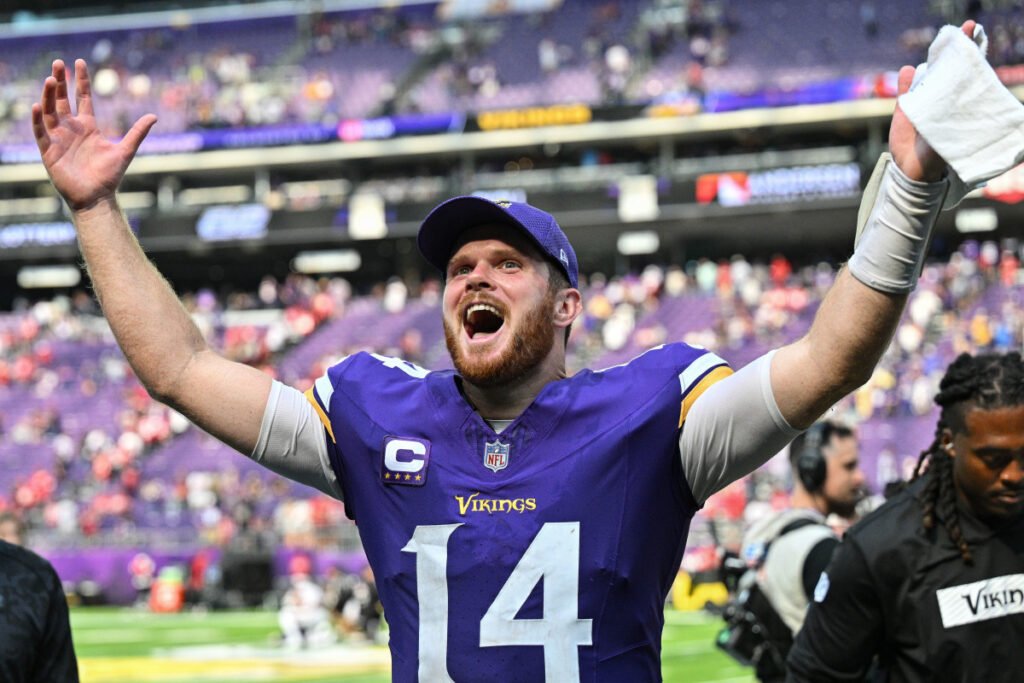Sam Darnold entered the NFL as one of the most highly touted quarterback prospects of his generation. Drafted third overall by the New York Jets in the 2018 NFL Draft, he was expected to be the franchise savior. However, his journey through the league has been anything but smooth. From his time in New York to stints with the Carolina Panthers and San Francisco 49ers, Darnold’s career has been a rollercoaster filled with ups, downs, and moments of unfulfilled potential. While still young, his future in the league remains uncertain, leaving fans and analysts questioning whether he can finally unlock his full potential.
College Stardom at USC
Darnold made a name for himself at the University of Southern California (USC), where he became the starting quarterback as a redshirt freshman in 2016. He led the Trojans to a thrilling Rose Bowl victory over Penn State, showcasing his ability to perform under pressure. His combination of a quick release, strong arm, and impressive mobility made him one of the top quarterback prospects heading into the 2018 NFL Draft.
During his time at USC, Darnold demonstrated an ability to make off-schedule plays, a trait that intrigued NFL scouts. However, his college career wasn’t without flaws—he struggled with turnovers, particularly fumbles, an issue that would follow him into the pros. Despite these concerns, his natural talent and leadership made him an easy choice for a top draft pick.
Draft Day Expectations and New York Jets Struggles
When the New York Jets selected Darnold third overall in 2018, expectations were sky-high. The team had long been searching for a franchise quarterback, and Darnold’s arrival was met with optimism. He showed flashes of brilliance, including a spectacular debut performance against the Detroit Lions, where he bounced back from an early pick-six to lead the Jets to a dominant victory.
However, his time in New York was defined more by struggles than successes. The Jets’ lack of offensive talent and poor roster construction made life difficult for their young quarterback. Several key factors contributed to Darnold’s struggles in New York:
- Poor offensive line protection: He was frequently under pressure, leading to rushed throws and poor decision-making.
- Lack of playmakers: The Jets failed to surround him with top-tier wide receivers and tight ends.
- Coaching instability: Under head coach Adam Gase, the offense lacked creativity and direction.
- Turnover issues: Darnold threw too many interceptions, often forcing plays that weren’t there.
Perhaps the defining moment of his tenure with the Jets came in 2019, when he was caught on the Monday Night Football broadcast saying, “I’m seeing ghosts.” This moment, indicative of his struggles with reading defenses, became a symbol of his difficulties in New York.
After three underwhelming seasons, the Jets decided to move on from Darnold, trading him to the Carolina Panthers in 2021.
Carolina Panthers: A Fresh Start That Didn’t Last

Hoping for a career revival, Darnold joined the Panthers with a chance to prove himself. He started strong, leading Carolina to a 3-0 record in 2021, and it seemed like he had finally turned a corner. He showed improved decision-making, and the Panthers’ offensive scheme allowed him to utilize his athleticism more effectively.
However, as the season progressed, Darnold regressed significantly. His struggles with turnovers returned, and he suffered an injury that sidelined him for several weeks. The Panthers experimented with multiple quarterbacks, including Cam Newton and P.J. Walker, which further destabilized Darnold’s role on the team.
Despite brief flashes of promise, his inconsistency made it clear that he wasn’t the long-term solution at quarterback. By the end of the 2022 season, Carolina moved in a different direction, drafting a new quarterback and signaling the end of Darnold’s time as a starter for the franchise.
San Francisco 49ers: The Backup Role and Future Prospects
In 2023, Darnold signed with the San Francisco 49ers as a backup. Learning under Kyle Shanahan’s system and alongside talented quarterbacks like Brock Purdy provided him with a valuable opportunity to reset his career.
As a backup, Darnold was no longer under the immense pressure of being the face of a franchise. This allowed him to refine his skills, improve his mechanics, and gain a better understanding of how a top-tier offensive system operates. While he didn’t see much playing time, the move to San Francisco could be a pivotal moment in his career, setting him up for future opportunities.
Strengths and Weaknesses in Darnold’s Game
Strengths:
- Arm Talent: Darnold has the ability to make deep and intermediate throws with velocity.
- Mobility: He can extend plays outside the pocket and scramble when necessary.
- Competitive Toughness: Despite facing adversity, he has remained determined to prove himself.
Weaknesses:
- Turnovers: Interceptions and fumbles have been a recurring issue throughout his career.
- Decision-Making: He sometimes forces plays instead of taking safer options.
- Inconsistency: He struggles with maintaining a high level of play over a full season.
What’s Next for Sam Darnold?
As Darnold enters the next phase of his career, he faces critical questions about his future. Can he still be a starting quarterback in the NFL? Will he find a team willing to give him another shot, or is he destined for a long-term backup role?
While still young, Darnold’s window to prove himself as a viable starting quarterback is closing. His best path forward may be to continue learning in a stable environment, much like Geno Smith, who revitalized his career later than expected. If Darnold can clean up his decision-making and turnovers, he may still have a future as a starting QB. However, if his struggles continue, he may transition into a career backup role, which still holds value in the NFL.
Conclusion: A Career at a Crossroads
Sam Darnold’s NFL journey has been filled with highs and lows, from being a top draft pick to struggling with multiple teams. His talent is undeniable, but his inconsistency has prevented him from reaching his full potential.
As he continues his career, his ability to adapt, improve, and capitalize on opportunities will determine whether he gets another shot as an NFL starter. Regardless of what happens next, his story serves as a reminder that quarterback success in the NFL is about more than just raw talent—it’s about the right system, coaching, and surrounding talent.
Whether Darnold finds redemption or settles into a backup role, his NFL story is far from over. The next few years will be crucial in defining his legacy in professional football.
Brad Marchand’s Rise to NHL Stardom: A Story of Skill & Grit





